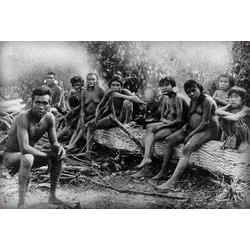|
|
|
| GGG managers are SunkenCiv, StayAt HomeMother & Ernest_at_the_Beach | |

|
|
Thanks Theoria. |
|
|
|
|
Posted on 04/04/2013 11:01:14 AM PDT by Theoria
From the paper:
In 1808 the Portuguese Crown declared “Just War” (Bellumiustum) against all Indian tribes that did not accept European laws (23). The fierce Botocudo were targeted in such wars and, in consequence, became virtually extinct by the end of the 19th century (24). Their importance for the history of the peopling of the Americas was revealed by studies reporting that the Botocudo had cranial features that consistently were described as intermediate between the polar Paleoamerican and Mongoloid morphologies (25, 26). Multivariate analyses of the cranial measures of different Amerindian and Paleoamerican groups from Brazil indeed concluded that the Botocudo Indians presented sufficient similarities with the Lagoa Santa Paleoamericans to be considered candidates to be their possible descendants (27).Possible explanations:
The first scenario, prehistoric, is related to the possibility of genetic continuity between the Paleoamericans from Lagoa Santa and Botocudo Indians (26, 27, 37), which indeed originally had motivated this study.
...
Another imaginable pre-Columbian scenario involves opportunities for more recent direct contact between Polynesia and South America before the European arrival. Such possibility of a direct movement from Oceania across the Pacific Ocean to the Americas was raised by Cann (43) on a discussion of the origin of the Amerindian B haplogroup. This finding prompted Bonatto et al. (44) to evaluate the likelihood of a Polynesian-Amerindian contact having occurred and conclude against it, although they could rule out neither minor contact events nor nonmaternal genetic exchange. New evidence from human and nonhuman material has become available since then. For example, there were archeological findings of Polynesian chicken bones in the Arauco Peninsula, in Chile (45) and evidence has been found in Easter Island of pre-Columbian presence of sweet potato and bottle gourd, both typical of South America (46, 47). Independent of the plausibility or implausibility of the pre-Columbian arrival of Polynesians to the South American Pacific coast, there still would remain the need to explain how these migrants crossed the Andes and ended up in Minas Gerais, Brazil. We feel that such a scenario is too unlikely to be seriously entertained.
...
The last scenario that we wish to assess is the possible arrival of Polynesian haplogroups to Brazil in modern times through the African slave trade from Madagascar, where 20% of the mtDNA lineages belong to the B4a1a1a haplogroup (29).
'Independent of the plausibility or implausibility of the pre-Columbian arrival of Polynesians to the South American Pacific coast, there still would remain the need to explain how these migrants crossed the Andes and ended up in Minas Gerais, Brazil. We feel that such a scenario is too unlikely to be seriously entertained.
‘unlikely to be seriously entertained’ ping.
‘...when you have eliminated all which is impossible, then whatever remains, however improbable, must be the truth.’
Sherlock Holmes
Thor Heyerdahl sailed the Kon-Tiki from Peru to Polynesia in 1947 to support his theory - did he have it backwards?
Thor Heyderdahl always maintained the opposite view... that early south americans traveled to Polynesia. That scenario may also fit the observed data.
the ocean was never a one way street.
They got picked up by a giant tsunami and thrown up `n over the Andes into Brazil.
And who knows when America was discovered...
In Newport, RI, there is an old tower which might be from the Vikings (no, not the Minnesota Vikings), and they found coal from Rhode Island at a Viking settlement in Greenland.
Interesting. I’ve heard that the Maori word for sweet potato, kumera (spelling?), is the same as a South American Indian word for it.
|
|
|
| GGG managers are SunkenCiv, StayAt HomeMother & Ernest_at_the_Beach | |

|
|
Thanks Theoria. |
|
|
|
|

"How rock art suggests a violent end for the "Australian" Americans However, the new evidence shows that these people did not arrive in an empty wilderness. Stone tools and charcoal from the site in Brazil show evidence of human habitation as long ago as 50,000 years.
It is a matter of survival of the fittest. Though they were fit enough to populate the expanses of the Pacific void, when placed in competition with the people of South America, they proved unfit and failed
No less plausible than the idiotic Bering Strait migration theory.
Disclaimer: Opinions posted on Free Republic are those of the individual posters and do not necessarily represent the opinion of Free Republic or its management. All materials posted herein are protected by copyright law and the exemption for fair use of copyrighted works.